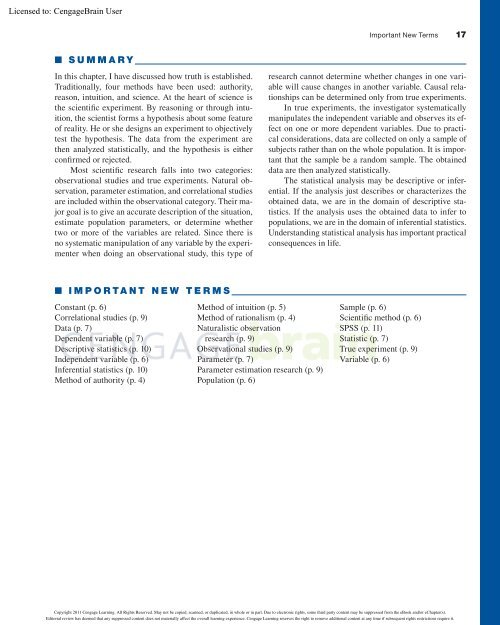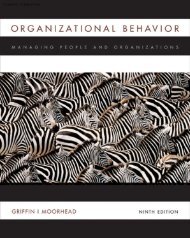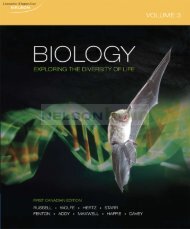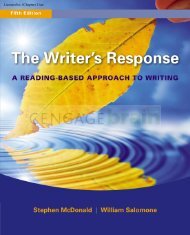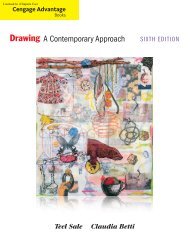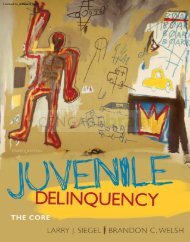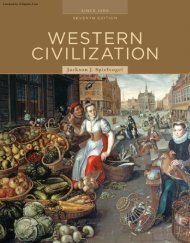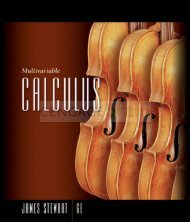Understanding Statistics in the Behavioral Sciences ... - NelsonBrain
Understanding Statistics in the Behavioral Sciences ... - NelsonBrain
Understanding Statistics in the Behavioral Sciences ... - NelsonBrain
You also want an ePaper? Increase the reach of your titles
YUMPU automatically turns print PDFs into web optimized ePapers that Google loves.
Licensed to:<br />
■ SUMMARY<br />
In this chapter, I have discussed how truth is established.<br />
Traditionally, four methods have been used: authority,<br />
reason, <strong>in</strong>tuition, and science. At <strong>the</strong> heart of science is<br />
<strong>the</strong> scientifi c experiment. By reason<strong>in</strong>g or through <strong>in</strong>tuition,<br />
<strong>the</strong> scientist forms a hypo<strong>the</strong>sis about some feature<br />
of reality. He or she designs an experiment to objectively<br />
test <strong>the</strong> hypo<strong>the</strong>sis. The data from <strong>the</strong> experiment are<br />
<strong>the</strong>n analyzed statistically, and <strong>the</strong> hypo<strong>the</strong>sis is ei<strong>the</strong>r<br />
confi rmed or rejected.<br />
Most scientifi c research falls <strong>in</strong>to two categories:<br />
observational studies and true experiments. Natural observation,<br />
parameter estimation, and correlational studies<br />
are <strong>in</strong>cluded with<strong>in</strong> <strong>the</strong> observational category. Their major<br />
goal is to give an accurate description of <strong>the</strong> situation,<br />
estimate population parameters, or determ<strong>in</strong>e whe<strong>the</strong>r<br />
two or more of <strong>the</strong> variables are related. S<strong>in</strong>ce <strong>the</strong>re is<br />
no systematic manipulation of any variable by <strong>the</strong> experimenter<br />
when do<strong>in</strong>g an observational study, this type of<br />
■ IMPORTANT NEW TERMS<br />
Constant (p. 6)<br />
Correlational studies (p. 9)<br />
Data (p. 7)<br />
Dependent variable (p. 7)<br />
Descriptive statistics (p. 10)<br />
Independent variable (p. 6)<br />
Inferential statistics (p. 10)<br />
Method of authority (p. 4)<br />
Method of <strong>in</strong>tuition (p. 5)<br />
Method of rationalism (p. 4)<br />
Naturalistic observation<br />
research (p. 9)<br />
Observational studies (p. 9)<br />
Parameter (p. 7)<br />
Parameter estimation research (p. 9)<br />
Population (p. 6)<br />
Important New Terms 17<br />
research cannot determ<strong>in</strong>e whe<strong>the</strong>r changes <strong>in</strong> one variable<br />
will cause changes <strong>in</strong> ano<strong>the</strong>r variable. Causal relationships<br />
can be determ<strong>in</strong>ed only from true experiments.<br />
In true experiments, <strong>the</strong> <strong>in</strong>vestigator systematically<br />
manipulates <strong>the</strong> <strong>in</strong>dependent variable and observes its effect<br />
on one or more dependent variables. Due to practical<br />
considerations, data are collected on only a sample of<br />
subjects ra<strong>the</strong>r than on <strong>the</strong> whole population. It is important<br />
that <strong>the</strong> sample be a random sample. The obta<strong>in</strong>ed<br />
data are <strong>the</strong>n analyzed statistically.<br />
The statistical analysis may be descriptive or <strong>in</strong>ferential.<br />
If <strong>the</strong> analysis just describes or characterizes <strong>the</strong><br />
obta<strong>in</strong>ed data, we are <strong>in</strong> <strong>the</strong> doma<strong>in</strong> of descriptive statistics.<br />
If <strong>the</strong> analysis uses <strong>the</strong> obta<strong>in</strong>ed data to <strong>in</strong>fer to<br />
populations, we are <strong>in</strong> <strong>the</strong> doma<strong>in</strong> of <strong>in</strong>ferential statistics.<br />
<strong>Understand<strong>in</strong>g</strong> statistical analysis has important practical<br />
consequences <strong>in</strong> life.<br />
Sample (p. 6)<br />
Scientifi c method (p. 6)<br />
SPSS (p. 11)<br />
Statistic (p. 7)<br />
True experiment (p. 9)<br />
Variable (p. 6)<br />
Copyright 2011 Cengage Learn<strong>in</strong>g. All Rights Reserved. May not be copied, scanned, or duplicated, <strong>in</strong> whole or <strong>in</strong> part. Due to electronic rights, some third party content may be suppressed from <strong>the</strong> eBook and/or eChapter(s).<br />
Editorial review has deemed that any suppressed content does not materially affect <strong>the</strong> overall learn<strong>in</strong>g experience. Cengage Learn<strong>in</strong>g reserves <strong>the</strong> right to remove additional content at any time if subsequent rights restrictions require it.


